Curly Top Virus
Guide H-106
Revised by Natalie Goldberg and Phillip Lujan
College of Agricultural, Consumer and Environmental Sciences, New Mexico State University
Authors: Respectively, Distinguished Extension Specialist Emeritus and Program Manager, Department of Extension Plant Sciences, New Mexico State University. (Print Friendly PDF)
Disease Identification and Management
Curly top virus (CTV), or beet curly top virus (BCTV) as it is more formally known, is widespread throughout arid and semiarid regions of the world. The virus is common in the western United States from Mexico to Canada and in the eastern Mediterranean Basin. The virus has a wide host range, causing disease in over 300 species in 44 plant families. The virus appears to be restricted to broadleaf plants because no monocotyledonous plants have been identified as hosts for this virus. The most commonly infected hosts include sugar beets (for which the disease was first named), tomatoes, peppers, beans, potatoes, spinach, cucurbits, cabbage, alfalfa, and many ornamentals. The virus also survives in many weeds, such as Russian thistle (tumbleweed) and mustards (London rocket and flixweed).
|
Diagnosis at a Glance |
|
|
Causes |
Geminivirus-a ssDNA virus |
|
Common Hosts |
Beets, tomatoes, peppers, beans, potatoes, spinach, cucurbits, many ornamentals, and weeds such as Russian thistle (tumbleweed) and mustards (London rocket and flixweed) |
|
Symptoms (vary on different hosts, but will include some of the following) |
Leaf and fruit deformation |
|
Stunting |
|
|
Leaves turn yellow and may develop purple veins |
|
|
Leaves twist and curl upward |
|
|
Leaves become thickened, stiff, and crisp |
|
|
Petioles curl downward |
|
|
Premature fruit ripening |
|
|
Reduced fruit quality and yield |
|
|
Infected young seedlings may die |
|
|
Transmission |
Beet leafhopper (Circulifer tenellus) |
|
Disease Conditions |
Warm temperatures and dense leafhopper populations |
|
Disease Management |
Cultural practices, including:
|
Symptoms vary depending on the host; however, this disease produces some general symptoms such as curling and twisting of the leaves. Figures 1 through 7 show disease symptoms on various plants. Other factors that relate to the type and severity of symptom development include virus strain and host physiology. Severity of disease is also dependent on the age of the plant when infected. For example, when young plants are infected they will often die shortly after infection. When plants are infected after the seedling stage, the plants survive but are yellow and stunted. Infected leaves of some hosts, particularly tomatoes and peppers, become thickened and crisp or stiff, and roll upward as the petioles curve downward. The leaves turn yellow with purplish veins. Leaves of other hosts such as beets become very twisted and curly. In most cases, yield is reduced, and the fruit that is produced ripens prematurely. The immature, dull, and wrinkled fruit is a good diagnostic symptom for tomatoes infected with CTV. If plants are infected after they have begun to set fruit, it is not uncommon to see infected and healthy fruit on the same stem.
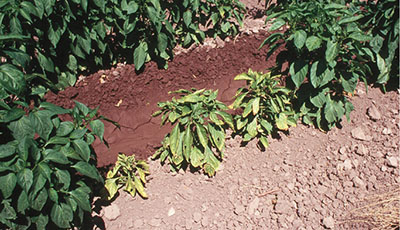
Figure 1. Symptoms of curly top infection on chile pepper.
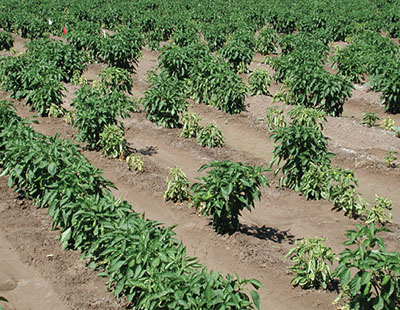
Figure 2. Symptoms of curly top infection on chile pepper.
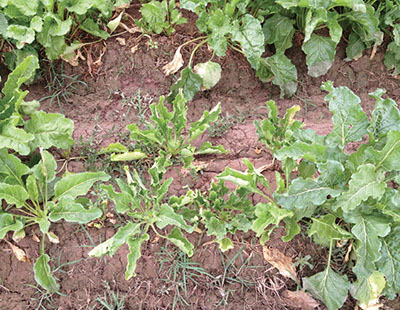
Figure 3. Symptoms of curly top infection on sugar beets.
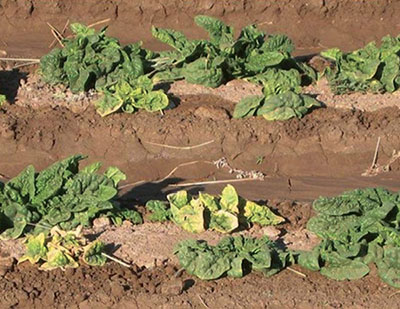
Figure 4. Symptoms of curly top infection on spinach.
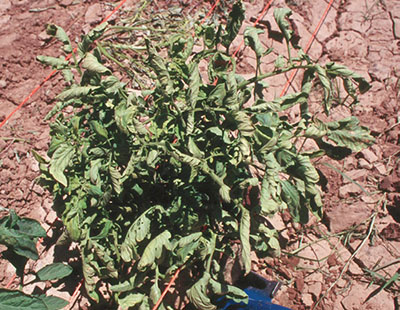
Figure 5. Symptoms of curly top infection on tomato.
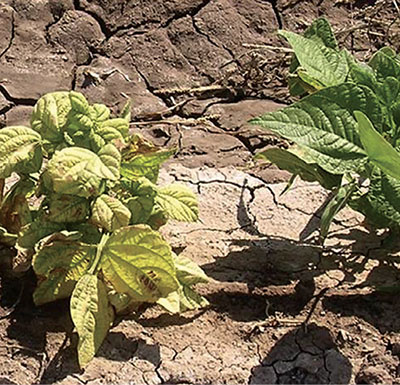
Figure 6. Symptoms of curly top infection on bean.
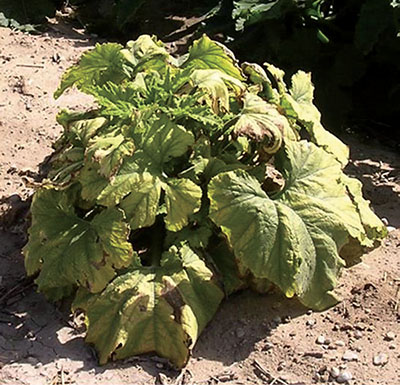
Figure 7. Symptoms of curly top infection on pumpkin (cucurbit).
This disease is transmitted (vectored) from infected to healthy plants by a small insect called the beet leafhopper (Circulifer tenellus; Figure 8). The leafhopper is an effective vector because it is able to transmit the virus after feeding on an infected plant for as little as one minute and can subsequently transmit the virus for the remainder of its lifetime (persistent manner). The virus is not passed on to leafhopper progeny. Although leafhoppers that feed on infected plants are able to transmit the virus for their entire life, the effectiveness of transmission is reduced when the insect does not continually feed on infected plants. Symptom development can occur as early as 24 hours in high summer heat, 12–14 days during average temperatures, and can be up to 30 days in cool temperatures.

Figure 8. Top and side view of beet leafhopper (Circulifer tenellus), vector of curly top virus.
While the disease can occur in commercial fields, it is particularly troublesome in home garden environments. The occurrence of this disease in home gardens may be due in part to the presence of alternate hosts that leafhoppers prefer to feed on, as well as an increased likelihood of infected source plants in the area (Figures 9–12).
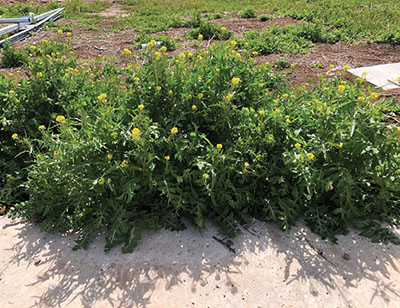
Figure 9. London rocket (Sisymbrium irio). (Photo courtesy of Dr. Leslie Beck, Extension Weed Specialist, NMSU.)
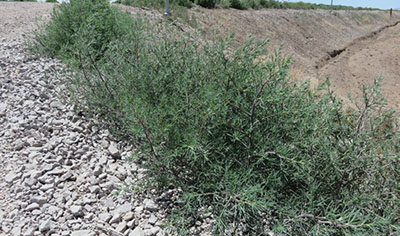
Figure 10. Russian thistle (Salsola tragus). (Photo courtesy of Dr. Leslie Beck, Extension Weed Specialist, NMSU.)
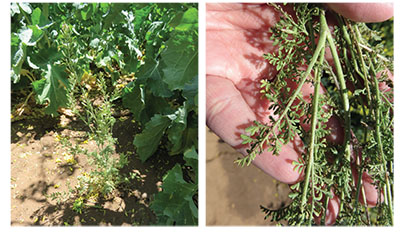
Figures 11 and 12. Flixweed (Descurainia sophia). (Photo courtesy of Dr. Leslie Beck, Extension Weed Specialist, NMSU.)
There are no chemicals available for controlling the virus, but several cultural practices can help reduce or eliminate infections. Although resistance to curly top is not known, growers may benefit from planting several different cultivars since some may be somewhat tolerant of the virus. Good sanitation practices, such as weed and insect control, are also essential for limiting the occurrence of the disease. Home gardeners may also consider planting susceptible hosts, such as tomatoes and peppers, in a slightly shaded part of the garden since leafhoppers prefer to feed in sunny locations. If the garden is in full sun, it may be helpful to place a netted cage over the plants when they are young. This netted material will provide a small amount of shade and, if the holes are small enough, will provide a physical barrier to prevent leafhoppers from getting to the plants. If a cage is used, be sure the plant doesn’t touch the netted material since this will reduce the effectiveness. Remove cages when the plants are mature because they are less susceptible to infection and will benefit from increased light for fruit development. All diseased plants should be removed from the field or garden as soon as they are noticed so that they do not continue to provide a source of the virus for transmission to healthy plants.
For Further Reading
H-158: How to Collect and Send Specimens for Disease Diagnosis
pubs.nmsu.edu/_h/H158/
H-242: Tomato Spotted Wilt Virus
pubs.nmsu.edu/_h/H242/
H-255: Iris Yellow Spot Virus
pubs.nmsu.edu/_h/H255/

Natalie P. Goldberg is a Distinguished Extension Specialist Emeritus in the Department of Extension Plant Sciences at NMSU. She earned her B.S. in ornamental horticulture from Cal Poly Pomona and her M.S. and Ph.D. in plant pathology from the University of Arizona. Her Extension program focuses on plant health management, plant disease identification, and crop biosecurity.

Phillip Lujan is the program manager and diagnostician for NMSU’s Plant Diagnostic Clinic. He received his B.S. and M.S. in agricultural biology with a minor in molecular biology from NMSU. He is currently researching the potential use of pecan byproducts on chile peppers for improved soilborne disease management.
To find more resources for your business, home, or family, visit the College of Agricultural, Consumer and Environmental Sciences on the World Wide Web at pubs.nmsu.edu.
Contents of publications may be freely reproduced, with an appropriate citation, for educational purposes. All other rights reserved. For permission to use publications for other purposes, contact pubs@nmsu.edu or the authors listed on the publication.
New Mexico State University is an equal opportunity/affirmative action employer and educator. NMSU and the U.S. Department of Agriculture cooperating.
Revised June 2021 Las Cruces, NM


